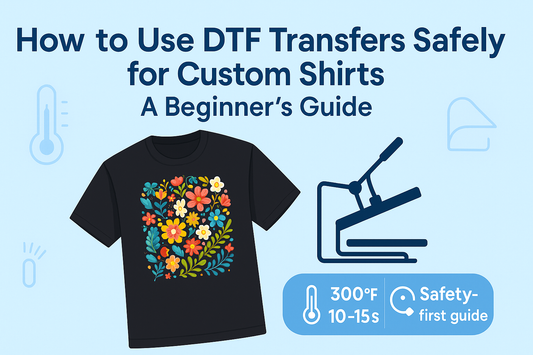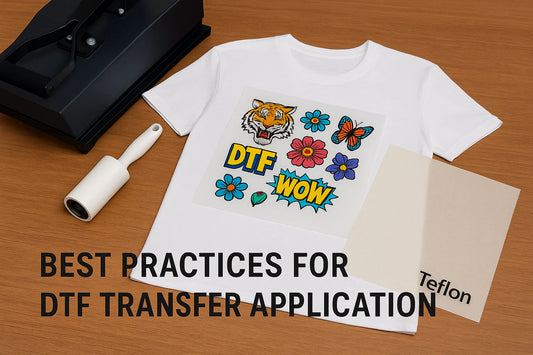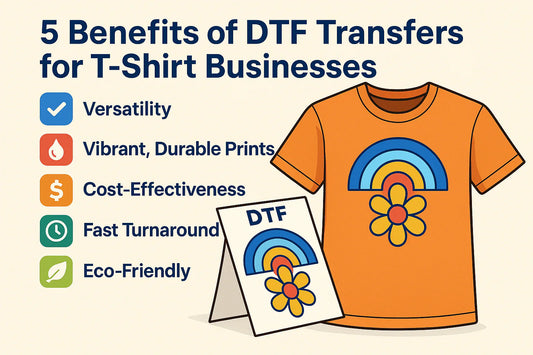DTF Transfer printing, or Direct-to-Film printing, is a modern technique that allows you to create colorful and detailed designs on various fabrics. This method is gaining popularity because it offers flexibility, high-quality prints, and vibrant colors. In this article, we'll explore how DTF printing works, the materials you can use, and why it's a great choice for full-color designs.
Key Takeaways
- DTF printing allows for unlimited colors in designs, making it perfect for creative projects.
- It works well on a variety of materials, including cotton, polyester, and even leather.
- The process is simple: print your design on a special film and then transfer it to fabric with heat.
- DTF transfers are durable and can withstand many washes without fading.
- This method is often more cost-effective than traditional printing methods like screen printing.
Understanding DTF Transfer Printing
What is DTF Transfer Printing?
DTF Transfer printing, or Direct-to-Film printing, is a modern method for creating custom designs on various materials. This technique allows you to print vibrant, full-color images directly onto a special film, which can then be transferred onto fabrics like cotton and polyester. One of the biggest advantages of DTF printing is that it can produce designs with unlimited color possibilities, making it a favorite among designers.
How Does DTF Transfer Printing Work?
The DTF printing process involves several key steps:
-
Design Creation: Start by designing your artwork using compatible file formats like JPG, PNG, or TIFF.
-
Printing on Film: The design is printed onto a special film using a DTF printer.
-
Applying Adhesive Powder: After printing, a special powder is applied to the wet ink to help it stick to the fabric.
-
Heat Transfer: Finally, the film is placed on the fabric and heat is applied using a heat press to transfer the design.
Benefits of DTF Transfer Printing
-
High-Quality Prints: DTF printing produces detailed and vibrant designs that stand out.
-
Versatility: It works on various fabrics, including dark and light materials.
-
Cost-Effective: Ideal for small batches, DTF printing eliminates the need for expensive setup fees.
DTF Transfer printing is a game-changer for custom apparel, allowing for creativity without limits.
In summary, DTF Transfer printing is a powerful tool for anyone looking to create stunning, full-color designs on fabric. With its ease of use and high-quality results, it’s no wonder that this method is gaining popularity in the world of custom printing.
Creating Full-Color Designs with DTF
Unlimited Color Possibilities
One of the greatest advantages of DTF printing is its ability to create full-color designs without any limitations. This means you can use as many colors as you want without worrying about extra costs. Here are some key points:
- No extra charges for color count.
- Freedom to be creative with your designs.
- Perfect for vibrant and eye-catching graphics.
Achieving Vibrant Gradients
DTF printing allows for smooth transitions between colors, making it easy to achieve vibrant gradients. This is especially useful for:
- Creating depth in designs.
- Making images look more realistic.
- Enhancing the overall visual appeal of your prints.
Reproducing Photographic Images
DTF printing excels at reproducing detailed photographic images. This method ensures that:
- Fine details are captured accurately.
- Colors remain bright and vivid even after multiple washes.
- The prints maintain their integrity over time, making them ideal for custom apparel.
DTF printing is a game-changer in the custom apparel industry, allowing for stunning designs that stand out.
In summary, DTF printing offers unlimited color possibilities, vibrant gradients, and the ability to reproduce photographic images, making it a top choice for anyone looking to create full-color designs. Whether you're designing for personal use or a business, DTF printing can help you achieve the results you want.
Materials Suitable for DTF Transfers

Compatible Fabrics and Surfaces
DTF transfers are versatile and can be applied to a wide range of materials. Here are some popular options:
-
100% Cotton: Ideal for vibrant colors and durability.
-
Polyester Blends: Works well, but may need special settings.
-
Canvas and Denim: Great for unique textures and styles.
-
Leather: Perfect for custom designs on accessories.
Special Considerations for Different Materials
When using DTF transfers, keep these tips in mind:
-
Pre-Pressing: Always pre-press the fabric to remove moisture.
-
Temperature Settings: Adjust the heat press temperature based on the material type.
-
Test First: Always test on a small area to ensure compatibility.
Tips for Best Results
To achieve the best results with your DTF transfers, consider the following:
- Use high-quality custom iron-on DTF transfers for better durability.
- Ensure your heat press is set correctly to avoid scorching.
- Store your custom iron on transfers for shirts in a cool, dry place to maintain quality.
DTF allows for vibrant, full-color designs without color limitations, making it suitable for various fabrics including cotton and leather. Durability is a key advantage of DTF transfers, ensuring your designs last longer than traditional methods.
Durability and Longevity of DTF Transfers
How Long Do DTF Transfers Last?
DTF transfers are known for their exceptional durability. With proper care, they can withstand over 45 washes without fading or cracking. This makes them a great choice for custom apparel that needs to last.
Preventing Color Fading
To keep your DTF transfers looking vibrant:
- Always wash garments inside out.
- Use cold water and a gentle cycle.
- Avoid bleach, as it can cause fading.
Maintaining Your DTF Printed Items
For long-lasting results, follow these tips:
- Store items in a cool, dry place.
- Avoid folding them in a way that puts pressure on the transfer.
- If you notice any peeling or cracking, address it immediately to prevent further damage.
By following these simple care instructions, you can ensure your DTF transfers remain vibrant and durable for a long time. No peeling, no wrinkles—just beautiful, lasting designs.
Comparing DTF with Other Printing Methods
DTF vs. Screen Printing
When comparing DTF (Direct-to-Film) printing with screen printing, several key differences emerge:
-
Setup Costs: DTF requires a lower initial investment compared to screen printing, which often needs multiple screens for different colors.
-
Design Complexity: DTF excels in producing intricate designs and vibrant colors, making it ideal for small batches. In contrast, screen printing is better suited for larger orders.
-
Durability: Screen printing is known for its durability, while DTF prints are also resilient but may feel slightly plasticized.
DTF vs. DTG Printing
DTG (Direct-to-Garment) printing is another popular method, and here’s how it stacks up against DTF:
| Feature |
DTF Printing |
DTG Printing |
| Investment |
Lower initial cost |
Higher initial cost |
| Production Speed |
Slower due to multiple steps |
Faster, prints directly on fabric |
| Color Quality |
Excellent for full-color designs |
Great, but may vary by fabric |
| Fabric Compatibility |
Works on various fabrics |
Best on cotton |
DTF vs. White Toner Printing
White toner printing is another method worth comparing:
-
Process Complexity: DTF is simpler as it prints the white layer simultaneously with the color layer, while white toner requires separate steps.
-
Cost Efficiency: DTF is generally more cost-effective, with lower consumable costs compared to white toner systems.
-
Print Feel: Both methods have a similar finish, but DTF inks provide greater elasticity and wear resistance.
In summary, DTF printing offers a versatile and cost-effective solution for creating vibrant, full-color designs on various fabrics, making it a strong contender against traditional methods like screen printing and DTG.
Troubleshooting Common DTF Issues

Fixing Transfer Peeling
One common problem with DTF printing is transfer peeling. This often happens when the heat or pressure settings are not correct. To fix this:
- Ensure your heat press is set to the right temperature.
- Follow the manufacturer's instructions closely.
- If peeling continues, consider using a heat press for more consistent results.
Addressing Color Fading
Color fading can be frustrating, especially after washing. To prevent this:
- Wait at least 24 hours before washing a freshly pressed garment.
- Always turn the garment inside out.
- Use a gentle wash cycle.
If you notice fading, it might be due to the quality of the inks or transfer paper used. For better results, use high-quality materials.
Handling Transfer Misalignment
Misalignment can ruin your design. To avoid this:
- Make sure your garment is flat and secure before applying the transfer.
- Use a ruler or a T-shirt alignment tool for precision.
- Double-check the placement before pressing.
Remember, taking care of your DTF transfers will keep them looking fresh and vibrant for a long time. Proper maintenance is key!
Advanced Techniques in DTF Printing
Using Gang Sheets for Efficiency
Using gang sheets is a smart way to maximize your printing space. This technique allows you to print multiple designs on a single sheet, which can save both time and materials. Here’s how to do it:
-
Design Preparation: Create your designs and arrange them on a single sheet.
-
Print: Use your DTF printer to print the gang sheet.
-
Cut and Transfer: Cut out the designs and transfer them to your fabric.
Incorporating Complex Designs
DTF printing allows for complex designs that can include multiple colors and intricate details. To achieve this:
- Start with a high-resolution image.
- Use layers to build depth in your design.
- Ensure proper alignment during the transfer process to avoid misplacement.
Exploring Creative Applications
DTF printing isn’t just for custom t-shirts; it can be used for various projects. Here are some creative ideas:
-
Custom Apparel: Create unique clothing items that stand out.
-
Home Decor: Use DTF transfers on pillowcases or curtains.
-
Personalized Gifts: Make special items for friends and family.
Remember: DTF printing offers endless possibilities for creativity. Whether you’re making custom apparel or unique gifts, the only limit is your imagination!
Conclusion
In summary, DTF transfer printing is a great way to create colorful designs on fabric. This method lets you use as many colors as you want without extra costs, making it perfect for creative projects. You can apply these transfers to many types of materials, like cotton and polyester, and they hold up well over time. Whether you're making custom shirts or unique gifts, DTF printing gives you the chance to express your ideas in a fun and vibrant way. So, if you're looking to bring your designs to life, DTF transfer printing is definitely worth considering!
Frequently Asked Questions
What is DTF Transfer Printing?
DTF Transfer Printing stands for Direct-to-Film printing. It's a modern method where designs are printed on a special film, which is then transferred onto fabrics using heat.
Can I use many colors in my DTF design?
Yes! One of the best things about DTF printing is that you can use as many colors as you want without any extra costs. This lets you create bright and colorful designs!
What materials can I use with DTF transfers?
DTF transfers work on many types of fabrics, like cotton, polyester, and even leather. You can also use them on canvas!
How long do DTF transfers last?
DTF transfers are quite durable. If applied correctly, they can last through many washes without fading or peeling.
How do DTF transfers compare to other printing methods?
DTF printing is great because it allows for full-color designs without needing separate screens for each color, unlike screen printing. It's also more flexible than DTG printing.
What should I do if my DTF transfer peels off?
If your DTF transfer peels, it might be due to incorrect heat or pressure. Make sure to follow the application instructions carefully for the best results.











0 comments